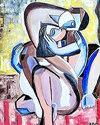创造力
IF 0.3
4区 社会学
0 HUMANITIES, MULTIDISCIPLINARY
ANGELAKI-JOURNAL OF THE THEORETICAL HUMANITIES
Pub Date : 2023-05-04
DOI:10.1080/0969725X.2023.2216550
引用次数: 0
摘要
摘要本文探讨了适应性创造力是如何在生活系统中不断产生和维持的。这项研究的哲学框架和动机将通过将实际的创造性过程与当前控制论自动化创造性的努力并置来介绍。过去和现在的过程哲学家批评了这些当代技术的隐含承诺,他们将为进一步的研究奠定基础。这项研究进展的试金石将根据两个概念的扩展来衡量:Gilbert Simondon(《技术对象的存在模式》)引入的虚拟性,以及Bacigalupi(《半生成:代理和结构的动态系统方法》)提出的相关噪声。为了完善虚拟性和相关噪声的概念,我们将提出一个严格的理论模型,其目的是解释真正的无限创造力。然后,该模型将作为一个启发式镜头,探索其他现存的模型,如Kuramoto模型(Strogatz),用于解释对多种生物现象中的适应性和创造性行为的经验观察。基于这些生物创造力的模型和对当代控制论项目的批判,本文将通过概述我们的文化目前对控制论世界观的承诺的伦理含义,以及我们如何超越它而进化。本文章由计算机程序翻译,如有差异,请以英文原文为准。
Creativity
Abstract This paper explores how adaptive creativity is continuously generated and sustained in living systems. The philosophical frame and motivations for this investigation will be introduced by juxtaposing an actual creative process with current cybernetic efforts to automate creativity. Past and present process philosophers that have critiqued the implicit commitments of these contemporary techniques will set the stage for further investigations. The litmus test of progress in this investigation will be measured against the extension of two concepts: virtuality, as introduced by Gilbert Simondon (On the Mode of the Existence of Technical Objects), and relevant noise, as introduced by Bacigalupi (“Semiogenesis: A Dynamic System Approach to Agency and Structure”). To refine the concepts of virtuality and relevant noise for our purposes, a rigorous theoretical model will be proposed whose intent is to explain veritable unbounded creativity. This model will then serve as a heuristic lens to explore additional extant models, such as the Kuramoto model (Strogatz), that are used to explain empirical observations of adaptive and creative behaviors in a diversity of biological phenomena. Based on these models of biological creativity and the critique of the contemporary cybernetic project, this paper will conclude by outlining the ethical implications of our culture’s current commitments to a cybernetic world view and how we might evolve beyond it.
求助全文
通过发布文献求助,成功后即可免费获取论文全文。
去求助
来源期刊

ANGELAKI-JOURNAL OF THE THEORETICAL HUMANITIES
HUMANITIES, MULTIDISCIPLINARY-
CiteScore
0.60
自引率
33.30%
发文量
57
期刊介绍:
Angelaki: journal of the theoretical humanities was established in September 1993 to provide an international forum for vanguard work in the theoretical humanities. In itself a contentious category, "theoretical humanities" represents the productive nexus of work in the disciplinary fields of literary criticism and theory, philosophy, and cultural studies. The journal is dedicated to the refreshing of intellectual coordinates, and to the challenging and vivifying process of re-thinking. Angelaki: journal of the theoretical humanities encourages a critical engagement with theory in terms of disciplinary development and intellectual and political usefulness, the inquiry into and articulation of culture.
 求助内容:
求助内容: 应助结果提醒方式:
应助结果提醒方式:


